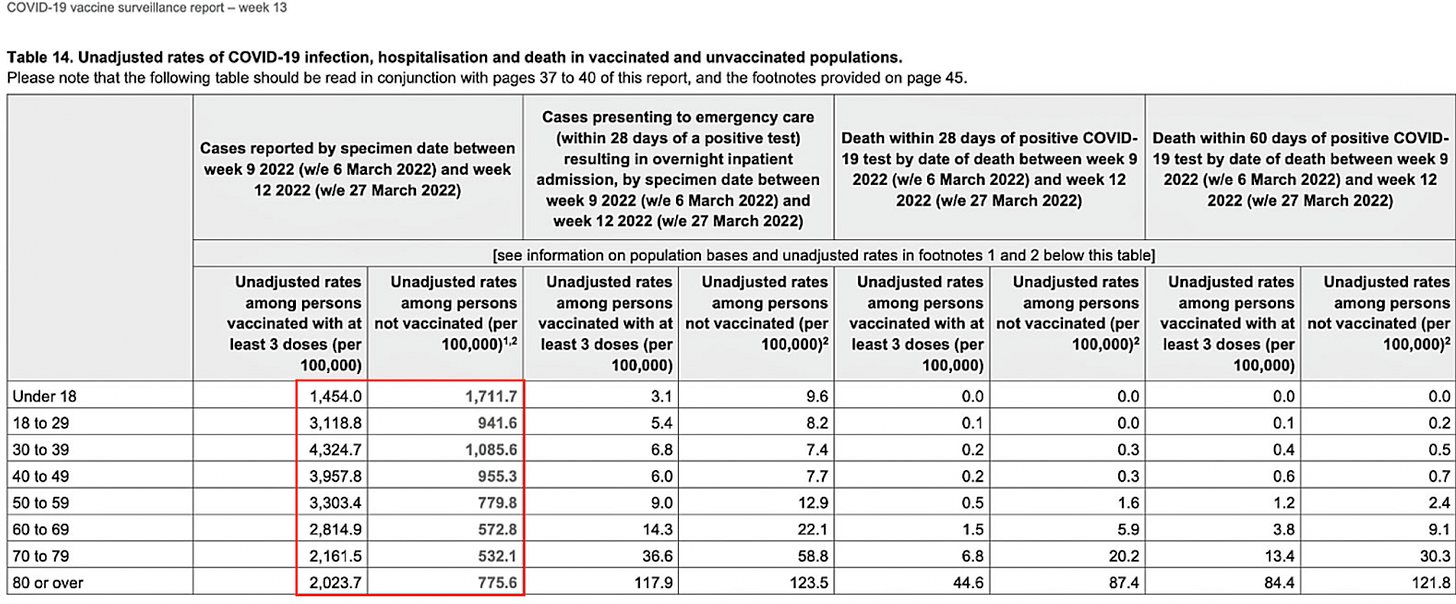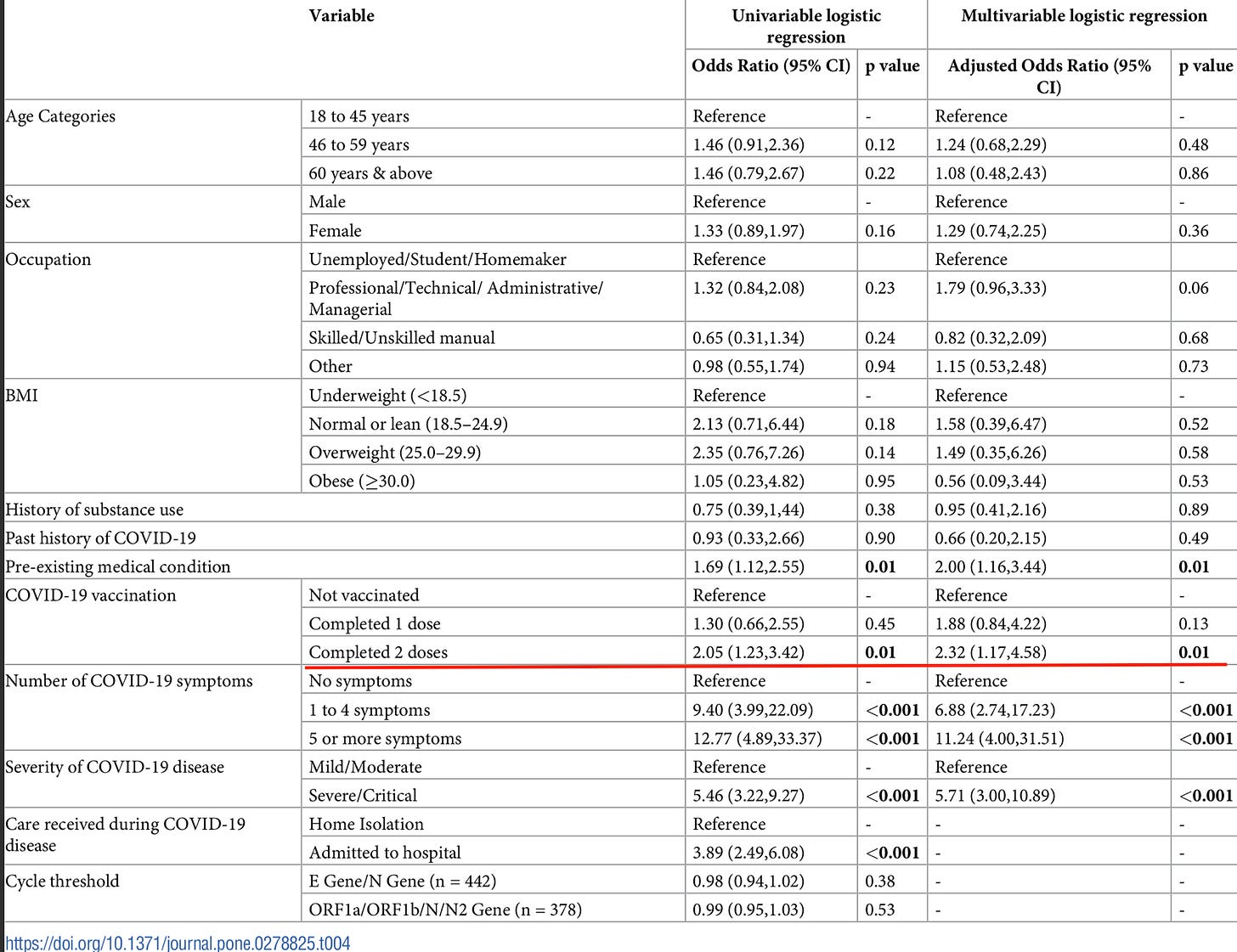Why the Vaccinated are More susceptible to infection
Hat tip to Igor Chudov who recently brought light to more evidence that repeated exposure to mRNA "vaccines" could increase infection rates
While attending the World Vaccine Congress in Washington in DC in April, 2023 I found myself sitting next to a sharply dressed alert woman at a break-out session about how to solve the vaccine-hesitancy “problem”. She smiled at me, so I introduced myself.
“Hi! My name is Madhava. I am an anesthesiologist working in Massachusetts.”
“I’m Jenny”, she said, “I’m the director of the UKHSA”.
I couldn’t believe my luck. I was handed the opportunity to ask Professor Dame Jennifer Margaret Harries some direct questions.
The United Kingdom Health Security Agency (UKHSA) was responsible for publishing the first large data sets which demonstrated an increased risk of contracting Covid if vaccinated in September of 2021:
In this four week period in September, 2021 vaccinated individuals over the age of 40 in the UK were succumbing to Covid more frequently than unvaccinated people of the same age. This was around the time when our authorities warned that the primary series was no longer effective and boosters were necessary to be “up-to-date”.
This was a stunning finding that backed up what we as individuals were experiencing around us. Vaccinated people were getting Covid everywhere, but could they be at increased risk than the unvaccinated? This should have been flagged as an enormous problem if true. This wasn’t a one-off. Subsequent UKHSA reports demonstrated that this trend worsened over time. By March of 2022 the surveillance data showed an enormous benefit to remaining unvaccinated, with respect to infection.
By March, 2022 vaccinated people in England over the age of 18 were getting Covid 3-4 times more frequently than the unvaccinated. By this time, the UKHSA surveillance report no longer put these data in an easy to read bar chart. If they did, it would look like this (Ouch!):
Instead, the data now appeared in tables with warnings to not draw the wrong conclusions.
The authors pointed out reasons for this paradoxical finding:
The vaccinated tested more frequently than the unvaccinated (possible),
Those getting vaccinated were sicker and more likely to contract Covid than their unvaccinated counterparts (possible but less likely—it’s generally accepted that there is an opposite dynamic in play, the healthy user bias)
Vaccinated people, thinking that they were protected, were more likely to put themselves at risk (this is bordering on ridiculous–people who chose to not get jabbed don’t hunker down at home in fear of being unprotected)
The unvaccinated were more likely to have gotten Covid previously and are thus less likely to have gotten infected during this time period.
This last explanation is actually a nod to natural immunity. However their own data debunks this hypothesis. The unvaccinated had lower rates of infection for half a year or more. The risk of infection among the vaccinated was growing by the month. This should have afforded them better protection in subsequent months, yet as time went by they became even more susceptible.
What changed in the intervening seven months?
The biggest change was that the majority of infections at this time, in the spring of 2022, was with the Omicron variant, a strain that was more infectious. This is reflected in the modestly higher rates of infection among the unvaccinated compared to those in September of 2021. But why were infection rates amongst the vaccinated 300-400% higher than they were seven months earlier (now with three doses)?
There was something else going on, something that couldn’t be explained by waning efficacy or different behaviors. That was the last month that UKHSA data included rates of infection by vaccination status.
I told Dr. Harries that her series of data may be contributing to the “vaccine” hesitancy “problem”. After all, why would someone get jabbed if it increased their risk of getting sick from the very same virus it was supposed to protect you from?
“If you are truly interested in countering vaccine skepticism,” I suggested, “you may wish to explain why this was happening in your country.”
Her countenance immediately changed. Her face tightened and she gave me a penetrating stare.
“I am not aware of such data”, she responded.
To her annoyance, I gave her the details. I had written about these data previously, the degree of negative effectiveness and the months when her agency published the data and how it inexplicably stopped reporting this metric. Her response:
“Those reports were written by people at the ONS (Office of National Statistics). They sometimes don’t understand how to interpret data.”
She turned away from me for good reason. After denying any knowledge of this data she admitted that those reports existed. She also didn’t want to answer the obvious question, why was the ONS and the UKHSA interpreting data? Their job was to report it.
The mysterious eruption of IgG4 in those vaccinated with mRNA shots
Independent researcher and substack author Igor Chudov recently wrote this explanatory article on IgG4:
He explains:
“IgG4 refers to a special rare subclass of antibodies instructing our immune system to ignore a pathogen rather than fight it.”
“While IgG4 antibodies may naturally appear in allergies due to repeat immune stimulations with allergens, they are inappropriate for replicating pathogens such as Sars-Cov-2.”
In the article linked above, Chudov summarizes the findings of a recent study, still in preprint, that showed that IgG4 antibody concentrations were 75 times higher in people who received three doses of mRNA “vaccines” compared to those who received Novavax, a traditional vaccine which used components of the SARS-COV2 virus to generate an immune response.
Why do the Pfizer and Moderna products designed on the mRNA platform generate this kind of response? Chudov earlier hypothesized that it was the lingering production of spike protein in the bodies of those who were jabbed. Prolonged and continuous exposure to the antigen eventually leads to the production of this subclass of antibody. This study supports his hypothesis.
Nobody knows for sure how long a person continues to synthesize spike protein after being inoculated with mRNA “vaccines”.
The CDC (Center for Disease Concoction and Perpetuation) has backpedaled on their stance around the persistence of the mRNA and spike protein after inoculation.
In July of 2021, they assured the public that our cells break down the mRNA and “gets rid of the mRNA soon after it is finished using the instructions.”:
That’s reassuring. But some time later they admitted that it will take a “few days” for the mRNA to be broken down, and that the spike protein may stay in the body for up to a few weeks:
One year later, by July of 2022, the CDC quietly decided to remove any mention of the persistence of mRNA and the synthesized spike protein in our bodies after vaccination:
There’s really nothing to see here, folks…
Does vaccination prevent “Long Covid”?
Our health authorities have given up on the idea that these mRNA products will stop transmission of Covid. Furthermore, claims that they have effectiveness against infection/hospitalization/death are based on confounded observational data that uses faulty means of calculating their utility (I explained this here based on some calculations by Norman Fenton and Mathew Crawford):
Instead, there has been recent interest in the purported reduction in “long Covid”. The popular substack author Katelyn Jetelina, a.k.a. “Your Local Epidemiologist” recently touted the findings of this study, which she believes proves that repeated mRNA “vaccine” doses will reduce the risk of long Covid.
However this study has a major flaw. It is well known that the risk of long covid is directly correlated with the severity of infection. In this study there was a large imbalance between the two groups: 60.2% of unvaccinated persons in the study were exposed to the alpha variant compared to the vaccinated where only 3.5% of them suffered infection with alpha.
The opposite was true with regard to Omicron, a less severe variant: Nearly 75% of the infections in the vaccinated occurred with Omicron compared to only 12.4% in the unvaccinated. The heterogeneity between the two cohorts was not mentioned by the authors but impacts the significance of their findings.
Moreover, the authors arbitrarily chose to exclude vaccinated people from their analysis if they contracted Covid within 28 days after getting jabbed. This resulted in the exclusion of 60 thousand from a cohort of 360 thousand. Why didn’t the authors study how those people fared with regard to long Covid as a matter of transparency and scientific rigor?
What might have happened if there were no arbitrary exclusion criteria for the vaccinated and if both cohorts were exposed to the same strain? These are the key results from a study that did just that:
In this study conducted in 2021, Covid-19 vaccination was independently associated with double the risk of developing long-Covid. The finding was statistically significant. Though the authors of the study considered this an “observational paradox”, there is at least one known mechanism which explains why prior vaccination can lead to more severe disease when exposed to a pathogen: Antibody-dependent Enhancement (ADE).
As is typical of YLE’s commentaries on research papers, only summaries of conclusions are given without any context or critical examination of the methodology used. Despite the serious difference between the two groups and the arbitrary elimination of 1 in 6 vaccinated individuals from analysis in the study she cites, vaccination still only offered a 1% reduction in the rate of long Covid after infection.
According to the UKHSA data, this tiny benefit comes with an infection rate that is 300-400% higher for nearly all age groups.
Evidence, it seems, is driving vaccine hesitancy more than anything else.














Great article, Dr. Betty. One has to wonder if these "vaccines" were specifically designed to break down the immune system. Nearly everyone I know who has been injected multiple times has struggled with a chronic cough, cold, repeated covid infections, etc. This is not even to mention the sudden deaths and turbo cancers. I think by now most people have a seemingly healthy friend or relative who has mysteriously died in the past two years. The local obituaries are chalk full of people dying in their prime. Excess death percentages are between 12-18 percent (or higher) in most vaccinated countries. With all federal agencies continuing to ignore this data and continually pushing the injections on pregnant women and children, I can only conclude that this was intentionally planned. I'm not sure how someone could logically come to any other conclusion. By the way, I feel sorry for people who follow "Your Local Epidemiologist" and hang on her every word. I wonder how much money she is making as a result of leading people astray?
Centre for Depopulation Control.